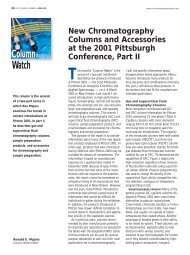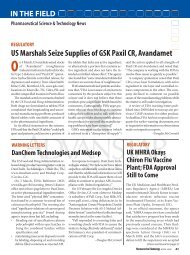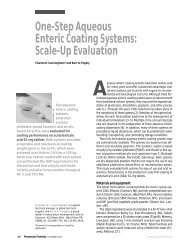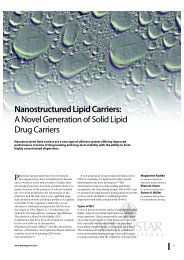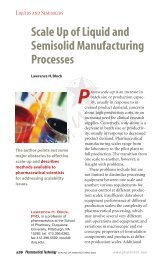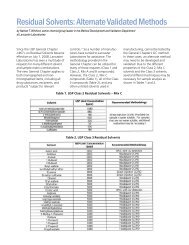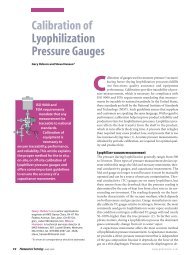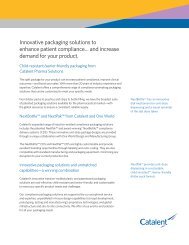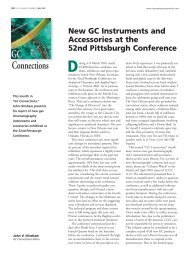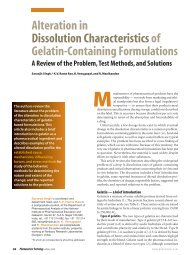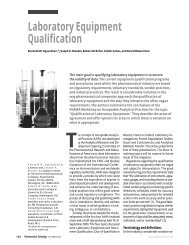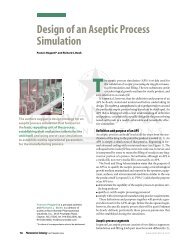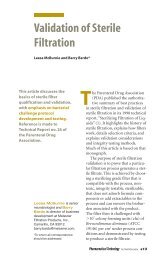Microcrystalline Cellulose Grade 12 versus Classic Grade 102
Microcrystalline Cellulose Grade 12 versus Classic Grade 102
Microcrystalline Cellulose Grade 12 versus Classic Grade 102
Create successful ePaper yourself
Turn your PDF publications into a flip-book with our unique Google optimized e-Paper software.
CV value (%)<br />
CV value (%)<br />
7<br />
6<br />
5<br />
4<br />
3<br />
2<br />
1<br />
0<br />
5<br />
4<br />
3<br />
2<br />
1<br />
MCC grade <strong>12</strong>/10%<br />
acetaminophen<br />
MCC grade <strong>102</strong>/10%<br />
acetaminophen<br />
MCC grade <strong>12</strong>/25%<br />
acetaminophen<br />
MCC grade <strong>102</strong>/25%<br />
acetaminophen<br />
MCC grade <strong>12</strong>/50%<br />
acetaminophen<br />
MCC grade <strong>102</strong>/50%<br />
acetaminophen<br />
5 min mixing 15 min mixing 30 min mixing<br />
Figure 4: Content uniformity of the various mixtures.<br />
MCC grade <strong>12</strong><br />
MCC grade <strong>102</strong><br />
Taking into consideration that the content uniformity<br />
results of the mixtures were better for grade <strong>12</strong> (see<br />
Figures 4 and 9–11), the uniformity–nonuniformity<br />
in weight is not the only reason for the uniformity–<br />
nonuniformity of content, even if the weight uniformity<br />
does influence the results in a strong way.<br />
In general, the tableting results are more important<br />
than the mixing results because the tablet is the final<br />
product, and the content uniformity of the tablets can<br />
be determined more precisely in terms of sampling<br />
than can the content uniformity of the mixtures.<br />
Both angle of repose and compressibility are used<br />
as measurements for the determination and description<br />
of powder flow properties (low values indicate<br />
good flow in both instances). In the example<br />
of the 50% acetaminophen tablet, the angle of repose<br />
of the grade <strong>12</strong> mixture was almost the same as<br />
that of the grade <strong>102</strong> mixture (see Figure 7). It could<br />
be expected that these mixtures would behave similarly,<br />
but the grade <strong>102</strong> mixture was not workable<br />
because of poor flow properties; therefore, the correlation<br />
was not satisfactory in this case. In addition<br />
to the angle of repose, the compressibility — as an<br />
effective index of compressibility (6) and flowability<br />
(7) — was determined. It is calculated using the<br />
following equation:<br />
compressibility(%) <br />
bulk density(tapped) bulk density(loose)<br />
bulk density(tapped)<br />
100<br />
0<br />
10%<br />
20 rpm<br />
10%<br />
40 rpm<br />
Figure 5: Tablet content uniformity.<br />
25%<br />
20 rpm<br />
25%<br />
40 rpm<br />
50%<br />
20 rpm<br />
50%<br />
40 rpm<br />
The compressibility values (see Figure 8) indicate<br />
clear differences between the mixtures; therefore,<br />
they correlate better with the tableting results obtained<br />
than with the corresponding angle of repose<br />
values.<br />
CV value (%)<br />
5<br />
4<br />
3<br />
2<br />
1<br />
0<br />
10%<br />
20 rpm<br />
10%<br />
40 rpm<br />
Figure 6: Tablet weight variation.<br />
25%<br />
20 rpm<br />
25%<br />
40 rpm<br />
MCC grade <strong>12</strong><br />
MCC grade <strong>102</strong><br />
50%<br />
20 rpm<br />
content uniformity results: Differences between the two MCC<br />
grades increased as the percentage of acetaminophen increased.<br />
To what extent the uniformity–nonuniformity in terms of content<br />
derives from the uniformity–nonuniformity in terms of<br />
weight is difficult to express numerically because content uniformity<br />
is dependent on many influences beside tablet weight<br />
(e.g., mixture uniformity and mixture stability during tableting).<br />
50%<br />
40 rpm<br />
Mixing and tableting of MCC with low<br />
concentrations of fine acetaminophen<br />
Method. MCC was mixed with fine acetaminophen<br />
in various proportions (0.1, 1.0, and 5.0% acetaminophen)<br />
in a twin-shell mixer for 5, 10, 15, and<br />
30 min. The mixtures then were tested for content<br />
uniformity as described in the previous section. Because<br />
of the reasons mentioned in that section, tablets<br />
were made from the 5-min mixture. After 0.5% magnesium<br />
stearate was added and mixing was performed<br />
for an additional 5 min, the mixtures were<br />
compressed to 180-mg tablets on a rotary press (Correct<br />
<strong>12</strong> 8-mm flat punches) at 20 and 40 rpm and a<br />
compaction force of 1.0 t. The tablets were tested for weight<br />
variation and content uniformity.<br />
Results and discussion.As expected, the RSD of the mixtures<br />
decreased as the active-ingredient content increased. The values<br />
generally were much higher than those obtained from experiments<br />
involving high concentrations of acetaminophen (see the<br />
previous section). Mixtures of grade <strong>12</strong> showed better and more<br />
56 Pharmaceutical Technology MAY 2002 www.pharmtech.com



